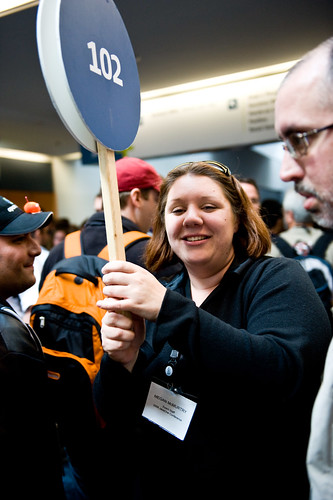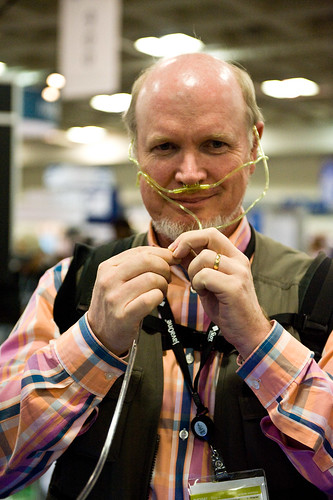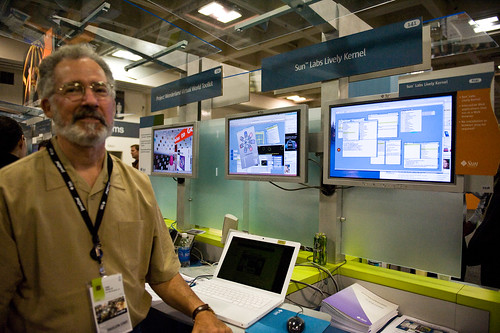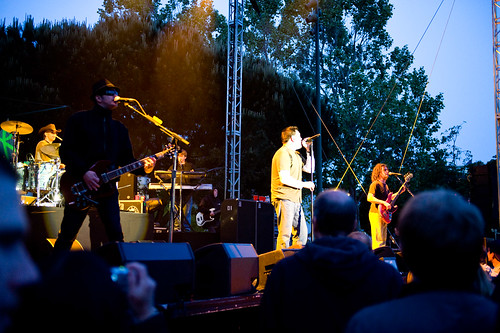I’ve been to so many conferences and seen so many talks that it’s hard for me to really get excited about conference presentations. I went to talks here and there, but nothing at JavaOne was really reaching out at grabbing me (in fairness, this happens at other conferences also, so it’s not just JavaOne). Or at least that was true until the last day.
Friday opened with a keynote by James Gosling, who served as the MC for a train of presenters on various cool projects.
Cool stuff
First up was Tor Norbye, who has done a lot of good work on support for editing different languages in NetBeans. Tor has been working on JavaScript support for NetBeans 6.1, and he showed off some cool features, like detecting all the exits from a function, semantic highlighting of variables, and integrated debugging between NetBeans and Firefox. All of which was cool. When I was managing the Cosmo group at OSAF, I tried a bunch of Javascript IDE’s and never really liked any of them. I haven’t done a lot with NetBeans 6.1 yet, but I will. Tor showed one feature, which was the killer one for me. NetBeans knows what Javascript will work in which browser. You can configure the IDE for the browsers that you want to support, and this affects code completion, quick fix checking and so on. Definitely useful. Here are several more references on the Javascript support in NetBeans 6.1.
The Java Platform
It’s easy for me (and others, I’d bet) to think mostly of JavaEE or perhaps JavaME when thinking about Java. That’s understandable given the worlds fixation on web applications, and looking ahead to mobile. But the majority of the talks in Gosling’s keynote session had nothing to do with Java SE, EE, or ME (at least in the phone sense).
Probably the hit (applause meter wise) of the keynote was LiveScribe‘s demonstration of their Pulse Smart Pen. This is an interesting pen that records the ink strokes that it makes, and any ambient audio that it records while the writing is happening. The ink and audio can be uploaded to a computer, as long as that computer runs Windows (apparently a Mac version is in the works). Unfortunately, the pen works by sensing marks on a special paper (that would be the razor blades), so there’s a limitation on how useful this can be. The presenter said that a future version of the software would allow people to print their own special paper, but that’s still a future item for now. By reading special marks on the special paper, you get a pretty cool user interface. The pen itself can run Java programs, and there is a developer kit available for it. If they can get by the limitation of special paper, I think that this is going to be pretty interesting.
Sentilla showed off their Mote hardware, which seem like RFID chips that can run Java programs. except that these RFID chips can form mesh networks amongst themselves and can have various kinds of sensors attached. There are lots of applications for these things, going well beyond inventory tracking and such.
Sun Distinguished Engineer Greg Bollella demonstrated Blue Wonder, which is a replacement for the computers used to control factories. Blue Wonder combines off the shelf x86 hardware, Solaris, and real time Java to provide a commodity solution for factory control applications. This is far afield of Web 2.0 applications, but just as cool, in my mind.
By the end of the keynote I was reminded of the long reach of the JVM platform, something that I’d lost sight of. The latest craze in the Web 2.0 space is location data — O’Reilly has an entire conference devoted to the topic. I think that sensor fusion of various kinds (not just location sensors) is going to play a big role in the next generation of really interesting applications. The JVM looks like it’s going to be a part of that. I don’t think than any other virtual machine technology is close in this regard.
Java’s future
I also went to a talk on Maxine, a meta-circular JVM. By the twitter reactions of the JRuby and Jython committers, I’d say that Maxine is going to get some well deserved attention when it is open sourced in June. I’m particularly interested because the PI’s for Maxine worked on PJava, and MVM. Given the differences between the Erlang VM and the JVM, I think that the ability to experiment with MVM is going to be pretty interesting. Apparently, there’s already some form of MVM support in Maxine – we’ll find out for sure in June.
During the conference I had a meeting with Cay Horstmann, and at the end of the meeting Josh Bloch saw Cay and wanted to talk to him about the BGGA closures proposal for Java. Turns out that Josh has an entire slide deck which consists of a stream of examples where BGGA does the wrong thing, generates really cryptic error messages, or requires an unbelievable amount of code. The fact that BGGA depends on generics, which are already really hard, doesn’t give me much confidence about closures in Java. If you are a statically typed language fan, I think that you ought to be worried about whether Java, the language, has any headroom left.
The last session that I went to was Cliff Click and Brian Goetz‘s session on concurrency. Unsurprisingly, the summary of the talk is “abandon all hope, ye who enter here”. I was glad to see a section in the talk about hardware support/changes for concurrency. The problem is that concurrency is going to introduce end-to-end problems, from the hardware all the way up to the application level, and I think that every stop along the way is going to be affected. Unlike sequential programming, where we are still largely reinventing the wheels of the past, there is no real previous history of research results to be mined for concurrency. Hotspot and other VM’s are close to implementing most of the tricks learned from Smalltalk and Lisp, but those systems were mostly used in a sequential fashion, and while there were experiments with concurrency, there was much less experience with the concurrent systems than the sequential ones. Big challenges ahead.




